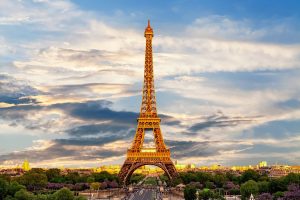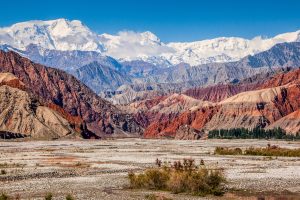
The year 1889 holds a dear place in the heart of every Ahmadi Muslim; it’s the same year that Hazrat Mirza Ghulam Ahmad (as) of Qadian (whom we believe to be the Promised Messiah and Imam Mahdi) founded our community the Ahmadiyya Muslim Jama’at and it’s the same year that marks the fulfilment of a prophecy through the birth of his son Hazrat Mirza Bashiruddin Mahmood Ahmad (ra) the Second Caliph of Islam Ahmadiyyat and the Promised Reformer.
But what else happened in the year 1889? What events were taking place in the wider world when the light that would someday come to illuminate every corner of it was just a small flame? What were people doing in a year whose full significance would only be common knowledge long after they had all departed from the land of the living?

The name of the Dutch painter Vincent van Gogh is universally acclaimed throughout the world of art; he became, after his death, one of the most well-known and influential artists in Western history. In the course of a single decade, he created over 2100 works of art, including 860 oil paintings. These are now among the most expensive artworks in the entire world.
Of all van Gogh’s paintings, the most famous is The Starry Night, widely considered to be his magnum opus or masterpiece. He painted it in June 1889, just three months after the Promised Messiah (as) made his claim and founded our community.
Many consider it the greatest painting in the history of art (even above Da Vinci’s Mona Lisa) and it is so ridiculously well-known that it requires no introduction from me.
But as an Ahmadi Muslim, I find it strangely symbolic; there are these huge outsized stars glowing like the halos of angels. The moon is also remarkably lustrous in the same way as the stars and is a crescent moon of the kind you might see on almost any Islamic flag. The moon is so bright in fact that it kind of looks like there’s a whole Sun behind it even though it’s definitely night time and the Sun hasn’t risen yet; it reminds me of an eclipse, a sign invoked by the Promised Messiah (as) as part of his claim. You might also be able to tell from the horizon that this is a painting of the world just before sunrise; it heralds the coming of a new dawn.
Moreover, there’s a whole little village of houses under the starry night sky. But the most prominent building is not the home of any person but rather a house of God; a church with a long spire. It reminds me of Minaratul-Masih (“The Messiah’s Minaret”) in Qadian, which was once just a small village and only later became known around the world as the birthplace of the Promised Messiah (as).

Of all the stars, the lowest one is the brightest; it has the biggest halo and the whitest shine. Astronomical research has since confirmed that this is the so-called Morning Star, “so-called” because the Morning Star isn’t really a star at all. It’s actually the planet Venus, which is sometimes close enough to our planet to be visible as a small star-sized light. Its position in the painting is roughly where it would have been in the view from van Gogh’s window in the summer of 1889. Venus in the form of the Morning Star is significant in many cultures and religions, including Islam; there’s even a short Surah or Chapter in the Holy Qur’an named after the Morning Star called Aṭ-Ṭāriq (الطارق). It begins as follows:
وَالسَّمَآءِ وَالطَّارِق
‘By the heaven and the Morning Star—‘ (86:2)
Whenever we find ourselves in any sort of difficulty, we should remember this other verse from Surah Aṭ-Ṭāriq:
اِنۡ کُلُّ نَفۡسٍ لَّمَّا عَلَیۡھَا حَافِظٌ
‘That there is no soul but has a guardian over it.’ (86:5)
We should remember that the protection of Allah the Almighty is always with us, we just have to ask and pray for it.
Such protection is especially comforting when we have cause to be concerned or afraid; for instance, if we see a massive creepy cypress tree like the one that appears in The Starry Night on the left side and covers a noticeable fraction of the painting. The tree appears to be much closer to the viewer than all the splendour which seems to be farther away and comparatively out of reach.
Cypress trees are supposed to be symbols of death; Vincent van Gogh actually died the next year. It was so soon that there could have been no way for the message of Ahmadiyyat to reach him; the dark tree was in the way and the village beneath the stars was too far off.
He died thinking he was a failure; no one liked his art at the time. It must’ve seemed like a wasted life. The Starry Night (along with the rest of van Gogh’s paintings) only became famous many years after his death. But this painting from 1889 is now one of the most renowned works in all of Western art. Today, it resides in The Museum of Modern Art in New York, where it’s been since 1941.
Vincent van Gogh never lived to see the world embrace his art or the religious revival that began in the same year that he painted The Starry Night, whereas today we are lucky to be able to plainly witness both of these. It makes me feel that, as Ahmadi Muslims, we should all feel truly blessed to be a part of this Community and never take that privilege for granted.
About the Author: Mansoor Dahri is an online editor for The Review of Religions. He graduated from UCL in BA Ancient Languages.




What a fascinating read! This is such a great idea and an important exploration to my mind, to seek out the social, cultural and lived experiences of this time in particular. I’m definitely going to enjoy this journey!